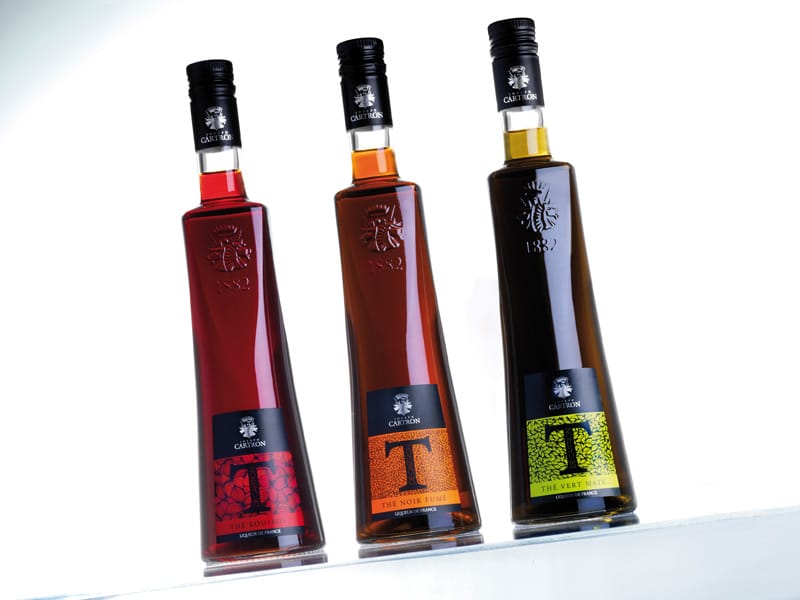by Simon Schmidlin, Sales Consultant, Gastronomy and Trade
History and Development
 How much poorer the world of pleasure would be without the wide variety of liqueurs — devoid of its many flavors, tempting sweetness, and unbelievable range of colors. No doubt, liqueurs are as beloved as they are successful. However, as always, when talking about original, traditional success recipes, there is always controversy regarding their exact origin. Often, it is an amalgamation of former knowledge that leads us to the product we recognize today. So it is a fact that in Italy, as early as the 15th and 16th centuries, fruits, herbs, and roots were infused in brandy. This simple maceration produced the first flavoured spirits. In an effort to make these more palatable, honey was added. The first named products were made from rose petals. These characterize the name, “Rosoli”, which has held a steadfast place in the world of liqueurs since the very beginning. At this time, the first liqueur recipes began to surface in France as well. Today, outstanding products can be found throughout the world, but for many connoisseurs, the top liqueurs still come from Italy and France.
How much poorer the world of pleasure would be without the wide variety of liqueurs — devoid of its many flavors, tempting sweetness, and unbelievable range of colors. No doubt, liqueurs are as beloved as they are successful. However, as always, when talking about original, traditional success recipes, there is always controversy regarding their exact origin. Often, it is an amalgamation of former knowledge that leads us to the product we recognize today. So it is a fact that in Italy, as early as the 15th and 16th centuries, fruits, herbs, and roots were infused in brandy. This simple maceration produced the first flavoured spirits. In an effort to make these more palatable, honey was added. The first named products were made from rose petals. These characterize the name, “Rosoli”, which has held a steadfast place in the world of liqueurs since the very beginning. At this time, the first liqueur recipes began to surface in France as well. Today, outstanding products can be found throughout the world, but for many connoisseurs, the top liqueurs still come from Italy and France.
Flavours that define an era
Production of liqueurs was continually refined and flavours designed to reflect the preferences of the times. Today, extraction (maceration) is often accomplished with a neutral alcohol. This is later diluted with water and attains its desired sweetness with the addition of sugar. In the production of several well-known liqueurs, the extraction (maceration) is further distilled. The essence thus produced is then mixed with a neutral alcohol, water, and sugar, which is the case with curacao and triple sec.
A Good Liqueur retains its aroma
Among liqueurs, connoisseurs recognize sweetened brandies that are flavored in various ways. Alcohol, sweetener and flavours are the base ingredients of a liqueur. What would a bar be without the wide variety of liqueurs and the wonderful possibilities they offer. Liqueurs can also attribute their arrival at the bar to their intense palette of colors. Liqueurs are not only a sweet seduction in terms of taste, they are also eye candy. They were therefore used early on in the mixing of cocktails — to delight guests with their exotic colors. Many classic cocktails are unthinkable without their requisite liqueur. Liqueurs attain their brilliant colors through the addition of various leaves, saffron, turmeric, or syrup, and, of course, artificial coloring.
Liqueurs for me
 What I find particularly fascinating about liqueurs is their endless versatility, whether in terms of aroma or color. Often I can give a cocktail that “certain something” with a perfectly-chosen liqueur. Many classic cocktails are unimaginable without liqueur. What is important to me is that a liqueur is not too sweet and that it retains its flavour. A cherry liqueur that only tastes like sweetened fruit is a long way from being a good cherry liqueur. I also find the liqueurs of the so-called spritz-cocktails exciting — think about the enormous success of the Aperol spritz, Campari Milano, Hugo, or Lillet Vive. Ranging from slightly sweet to dry or even bitter — there is something for everyone. And the source inspiration is always a liqueur.
What I find particularly fascinating about liqueurs is their endless versatility, whether in terms of aroma or color. Often I can give a cocktail that “certain something” with a perfectly-chosen liqueur. Many classic cocktails are unimaginable without liqueur. What is important to me is that a liqueur is not too sweet and that it retains its flavour. A cherry liqueur that only tastes like sweetened fruit is a long way from being a good cherry liqueur. I also find the liqueurs of the so-called spritz-cocktails exciting — think about the enormous success of the Aperol spritz, Campari Milano, Hugo, or Lillet Vive. Ranging from slightly sweet to dry or even bitter — there is something for everyone. And the source inspiration is always a liqueur.
Liqueurs are trending
Spritz cocktails reflect the tastes of the times and are currently very much in fashion. What began with Aperol Spritz, has experienced unbridled hype over the last several years with drinks like Hugo & Co. Trendy drinks of this type can be found at virtually any bar — and the new arrivals make great summer drinks.
New announcement: Soft flavors derived from tea and flowers
In bars around the world, it is becoming increasingly more common to find varieties of liqueurs that reflect aromas derived from teas and flowers. As a bartender, I find the Roobios Liqueur by Joseph Cartron particularly attractive for summer cocktails. This liqueur is produced from the bark of South-African Rooibos bushes. Despite its creamy sweetness, it does not lose its original flavours of the Roobios tea. I am thrilled that the natural bitters of the tea also influence its taste. This makes the liqueur highly authentic. For summer, I recommend a simple concoction that can be made at home as an aperitif.
Summer Drink with Rooibos Liqueur
- Fill half a wine glass with ice
- add 3 cl Joseph Cartron Rooibos Tea Liqueur
- add 1,5 cl Berry Liqueur (for example, Joseph Cartron Crème de Mure)
- add apple juice spritz
- garnish with orange zest and mint leaves
This way you will have a delicious spritzer in no time and you will surely be serving something different.
Josef Cartron –Liqueurs from Flavour Architects
 For me, the liqueurs of Joseph Cartron are among the best. The quality of every product is one-of-a-kind as the natural flavours of the fruits used are highlighted. The “bitter” taste of grapefruit is easily discernible in the grapefruit liqueur. This is very important to me — I find that an overly sweet liqueur destroys the taste of the fruit. The unbelievably intense flavours are a direct result of the attention to detail that characterises the work at Cartron. The small distillery, located in Nuits-Saint-Georges, in the heart of Burgundy, is renowned for its high standard of quality and authenticity of fruit used in the production process. By now, this treasure trove for liqueur lovers is lead by the fifth generation of distillers and serves as a mecca for pleasure seekers with a fondness for flavour. The key to their enormous success is the careful selection of fruit. Love of tradition contributes to their appreciation, sustainability, and regionalism. In order to maintain the high quality of the fruit, the distillery has continued to work with the same local farmers for generations. These fruits create the harmonious freshness and the intense flavour of the fruit liqueurs produced by Joseph Cartron.
For me, the liqueurs of Joseph Cartron are among the best. The quality of every product is one-of-a-kind as the natural flavours of the fruits used are highlighted. The “bitter” taste of grapefruit is easily discernible in the grapefruit liqueur. This is very important to me — I find that an overly sweet liqueur destroys the taste of the fruit. The unbelievably intense flavours are a direct result of the attention to detail that characterises the work at Cartron. The small distillery, located in Nuits-Saint-Georges, in the heart of Burgundy, is renowned for its high standard of quality and authenticity of fruit used in the production process. By now, this treasure trove for liqueur lovers is lead by the fifth generation of distillers and serves as a mecca for pleasure seekers with a fondness for flavour. The key to their enormous success is the careful selection of fruit. Love of tradition contributes to their appreciation, sustainability, and regionalism. In order to maintain the high quality of the fruit, the distillery has continued to work with the same local farmers for generations. These fruits create the harmonious freshness and the intense flavour of the fruit liqueurs produced by Joseph Cartron.


